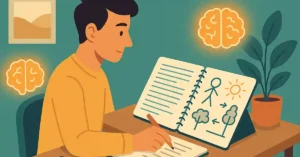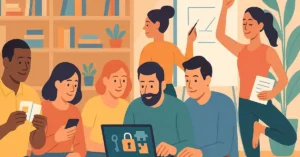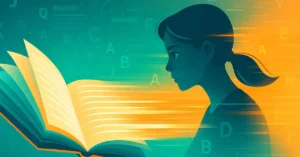Reading comprehension is the happy moment when the squiggles on a page turn into living ideas in your head. It’s not just pronouncing words; it’s connecting them to meaning, prior knowledge, and “A-ha!” insights. If you’ve ever reached the bottom of a page and thought, What did I just read?, this article is for you.
Below, I share nine strategies I use with students (and myself) to level-up understanding. Each is backed by solid research—no unicorn dust required. Let’s dive in.
1. Build Background Knowledge on Purpose
Texts make more sense when you already know something about the topic. Meta-analyses show that explicit content instruction—think pre-reading videos, quick K-W-L chats, or related fiction—correlates strongly with better comprehension scores for all readers, including multilingual learners. (Springer)
Try it: Before tackling a dense article on plate tectonics, watch a two-minute animation of continental drift or skim a volcano infographic.
2. Grow Vocabulary (and Use It)
Knowing the words means you spend less brainpower decoding and more power understanding. Interventions that pair word study with immediate feedback boost both fluency and comprehension. (ScienceDirect)
Try it: Keep a running “word wall” in a notebook. Sketch or act out new terms—your memory loves multisensory hooks.
Master Speed Reading and Memory
Unlock the secrets of speed reading and memory mastery. This practical guide helps you boost your reading speed, sharpen recall, and learn smarter—starting today.
3. Teach Your Brain to Talk Back: Self-Questioning
Asking “Why did the author include that?” or “What might happen next?” turns passive eyes into active minds. A 57-study meta-analysis found metacognitive strategies, like self-questioning, had a moderate-to-strong relationship with comprehension across grades. (Frontiers)
Try it: Pause every few paragraphs and jot one “I wonder…” question—then hunt for the answer.
4. Explain It to Yourself (Yes, Out Loud)
Self-explanation training—rephrasing, making predictions, bridging ideas—significantly improves understanding, even for complex science texts. (ERIC)
Try it: After a key paragraph, close the book and explain it to an imaginary goldfish. If the fish looks confused (okay, you feel confused), reread.
5. Summarize & Retell
Boiling text down to the main idea plus two or three crucial details cements meaning in memory. Bayesian network analyses rank main-idea and summarization work among the most effective strategies for struggling readers. (ResearchGate)
Try it: Use the “Somebody-Wanted-But-So-Then” frame to retell a chapter in five bullets.
6. Map It Out with Graphic Organizers
From Venn diagrams to story mountains, organizers make invisible structures visible. Reviews consistently report positive effects on comprehension, writing, and recall. (ERIC)
Try it: While reading nonfiction, fill a concept map that links the central idea to key facts and examples.
The Silent Guardian
A vow of silence. A mission across centuries. One assassin holds the fate of humanity in his hands.
Adam never chose to be silent; the Phylax demanded it. Trained from childhood as a time-traveling enforcer, he slips through centuries to eliminate those who threaten the future. His latest mission: assassinate Emperor Qin Shi Huang before a ruthless plot ultimately destroys humankind.
7. Practice Reciprocal Teaching (Four Brains Are Better Than One)
The classic “predict-question-clarify-summarize” cycle, done in small groups, raises comprehension in randomized-controlled studies across elementary and secondary classrooms. (Queen’s University Belfast)
Try it: In a study group, rotate roles—one predictor, one questioner, one clarifier, one summarizer—every two pages.
8. Boost Fluency With Feedback
When readers quickly recognize words and phrasing, mental energy shifts to meaning. Studies show fluency drills paired with immediate corrective feedback yield measurable comprehension gains. (ScienceDirect)
Try it: Record yourself reading a paragraph, play it back, and aim to beat your accuracy (not just speed) on the next take.
9. Keep Teachers Learning, Too
Teacher professional-development in comprehension strategies reliably improves classroom results—proof that instruction quality matters. (Wiley Online Library)
Try it: If you’re an educator, choose one strategy above, watch a demo video, and test it in tomorrow’s lesson.
Quick-Start Checklist
Pick one strategy (self-questioning is my gateway favorite).
Model it aloud. Narrate your thought process so students see how comprehension happens.
Practice in short bursts—five-minute mini-lessons stick better than 40-minute marathons.
Reflect and adjust. Ask, “Did this make the text clearer?” Tweak and repeat.
Final Thoughts
Improving reading comprehension isn’t magic; it’s method. By mixing background knowledge, vocabulary, metacognition, collaboration, and a sprinkle of humor, we turn reading from a chore into Sherlock-level sleuthing. Try these nine tools, keep what clicks, and watch those “Huh?” moments turn into “A-ha!” moments.
And hey—if you catch me mumbling explanations to an imaginary goldfish, don’t judge; I’m just practicing what the science preaches.







